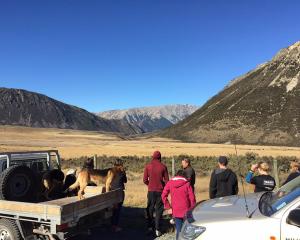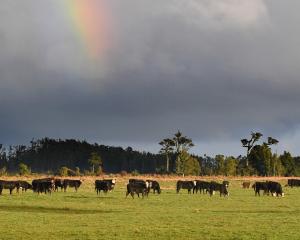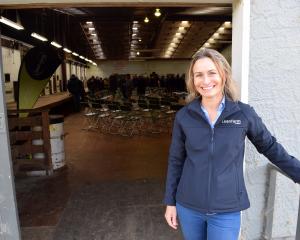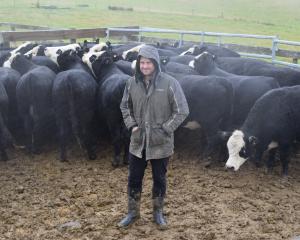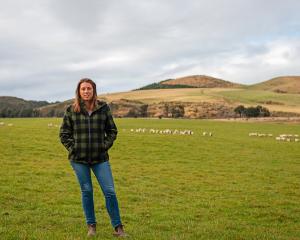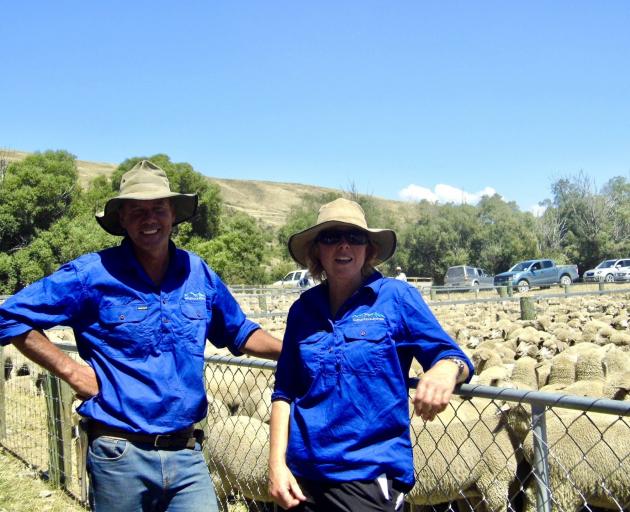
The farm’s autumn window for growth shut down last month with the first frosts arriving in the middle of March.
"We don’t have a window left of growth for winter," Mrs Harmer said.
"So all we’re going to do is batten down the hatches and work out what we’re going to feed and how do we look after our capital stock. We have got rid of every surplus animal on the place that we can other than the merino wether lambs and they don’t take a lot to feed and will go in July anyway. There’s been an opportunity cost — we lost a lot of money by selling those other lambs early, but we had to."
She outlined the toll of drought on the station to about 70 farmers attending Beef + Lamb NZ’s (B+LNZ) Farming for Profit: When will it rain field day at Windwhistle’s Tui Estate.
This was tempered with the wisdom of making quick and early decisions to prevent further pain.
The Harmers run just under 6000ha in the Ashburton Gorge in the middle of the valley in a rain shadow with much less rainfall than other properties around them.
Their Merino ewe breeding operation has about 13,000 ewes, as well as 600 Angus beef cows and about 230 hinds.
"So it’s all about capital stock for us and to give you an idea of what this season has meant for us I did a quick work out and we’ve been measuring rainfall for the last 30-odd years we’ve been up there and we’ve actually only hit our average monthly rainfall target twice since December 2022. Our last significant rainfall was snowfall events last October and so we went from a cold spring to a dry spring and didn’t get our normal rainfall."
Castle Ridge collected 25mm in November, followed by 14.5mm the next month and 43mm in January after two small rainfalls.
"We’re used to dry so we plan for it. This season has probably been a little bit more so than usual."
The couple spilt their heifer calves at calving from steer calves each year.
To counter feed getting tight in a dry summer they have only had to put the heifer calves and cows on to the hill before weaning a couple of times and this is the first time they have weaned the heifer calves early.
This reduces their feed requirements with these calves staying with 250 to 260 cows on poorer quality feed as they need another year of growing before they can go to the bull.
That means their good-quality feed can go to their steer calves to be sold in autumn.
They realised more steps needed to be taken when it became apparent in November there was little rain and they could only take one cut of lucerne.
"One of the big decisions we made was to buy in baleage so we went straight to our contractor in November when we did that first cut and we managed to hold our price that we purchased it at and he’s still dribbling it into us as it’s being made. But at least we know it’s coming in and we managed to lock in a price earlier that was a lower cents per kilogram of dry matter than what is now sitting on the market and is likely to go up in the next few weeks."
The cull cows have gone and other in-calf cows will be kept in the best condition they can on lower quality feed.
"They are currently on very little, but we know they’re in calf and we know they’re fat at the moment. So they will just sit there on hold and that’s freed up a whole lot of feed on the flats that those cows aren’t eating. That’s worked really well for us."
Castle Ridge’s lambs from mixed age ewes going to a poll dorset terminal sire normally are sold at an on-farm lamb sale in the first week of February.
"We pulled the lamb sale forward a week and that got 8500 lambs off the place ... and the 1000 shorn cull ewes went ... all earlier than normal and it still didn’t look as though it was going to rain."
Two weeks after that, they revised their usual practice of taking 1000-odd leftover lambs through winter and selling them after they are shorn in July for their halfbred wool.
"This year we said we’re going to have to bite the bullet and they went to Temuka as store lambs and we were very lucky because we got them in there a week before the market crashed. So that was a bonus, but it was also early decision making. I look back and reflect what’s different from what we’ve done in the past and I think we have been more proactive and earlier in our decision making than ever before."
She said that was starting to pay dividends now.
Usually over 300ha of winter crops are planted, but after getting their swedes in and spraying off the next paddocks for turnips to feed young stock they made the call against putting the drill in the ground because of the rain shortage.
Only in the second week of March did they get the cross-slot drill out again — for ryecorn — after a 17mm rain. Ryecorn is used as a tool particularly for breaking down thatch, but this year it was used to replace winter feed.
"Now that’s not going to grow us 6 [tonnes] to 8 tonnes of winter feed [per hectare], but it will give us something to feed in early spring because after a week it’s out of the ground from moisture in there — not much — but enough obviously to strike it. That will give us at least a couple of tonnes to feed and we can then lamb ewes on that and to extend our rotation and hold off grass if we start to get grass growth."
With the growth window behind Castle Ridge, the Harmers will concentrate on feeding barley to ewes with the poorest condition scores.
Mrs Harmer said they would carry on doing this as it was the most efficient and cost-effective option.
The main ewes would get some barley at tupping on top of diminished winter crops and baleage brought in.
"Our cost of production will be significantly higher, but we have to look after those capital stock and grazing off farms isn’t such an easy option for merino ewes. We could get rid of cattle as far as the heifers go but that’s about the only class of stock we could send away grazing realistically. The cows will just work on hill country and use fat off their backs we’ve been building the past couple of years."
About three years ago an "incredible" spring resulted in four cuts of lucerne which they use for winter baleage. As they did not need to graze the fourth cut because they had plenty of feed, they stored it as a bun, only using some last winter.
The rest will get their deer through the winter.
"That’s what we were waiting for. Normally I would say we make two years of winter baleage and very rarely is there much left. Well that was our extra and it will be gone at the end of winter. So next spring we will have to look at what we’re going to do. We are already thinking of that stuff now. We made a whole lot of decisions about the dry summer early and now we’re making decisions about winter and spring. For us winter is our biggest challenge because we are high altitude."
Mrs Harmer said they had talked to their accountant and bank manager in February to make sure they had the capacity to buy in extra feed this winter.
She said some years farmers had to accept they would not get every last dollar and the stock would not look as good as they wanted, but nobody could be perfect all the time.
"All you can do is the best you can do and deal with what comes along."


